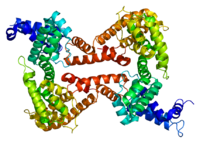
Photo from wikipedia
Abstract Plasma protein binding (PPB) studies on the SARS-CoV-2 main protease inhibitor nirmatrelvir revealed considerable species differences primarily in dog and rabbit, which prompted further investigations into the biochemical basis… Click to show full abstract
Abstract Plasma protein binding (PPB) studies on the SARS-CoV-2 main protease inhibitor nirmatrelvir revealed considerable species differences primarily in dog and rabbit, which prompted further investigations into the biochemical basis for these differences. The unbound fraction (fu) of nirmatrelvir in dog and rabbit plasma was concentration (2–200 µM)-dependent (dog fu,p 0.024–0.69, rabbit fu,p 0.010–0.82). Concentration (0.1–100 µM)-dependent binding in serum albumin (SA) (fu,SA 0.040–0.82) and alpha-1-acid glycoprotein (AAG) (fu,AAG 0.050–0.64) was observed in dogs. Nirmatrelvir showed minimal binding to rabbit SA (1–100 µM: fu,SA 0.70–0.79), while binding to rabbit AAG was concentration-dependent (0.1–100 µM: fu,AAG 0.024–0.66). In contrast, nirmatrelvir (2 µM) revealed minimal binding (fu,AAG 0.79–0.88) to AAG from rat and monkeys. Nirmatrelvir showed minimal-to-moderate binding to SA (1–100 µM; fu,SA 0.70–1.0) and AAG (0.1–100 µM; fu,AAG 0.48–0.58) from humans across tested concentrations. Nirmatrelvir molecular docking studies using published crystal structures and homology models of human and preclinical species SA and AAG were used to rationalise the species differences to plasma proteins. This suggested that species differences in PPB are primarily driven by molecular differences in albumin and AAG resulting in differences in binding affinity.
Journal Title: Xenobiotica
Year Published: 2023
Link to full text (if available)
Share on Social Media: Sign Up to like & get
recommendations!